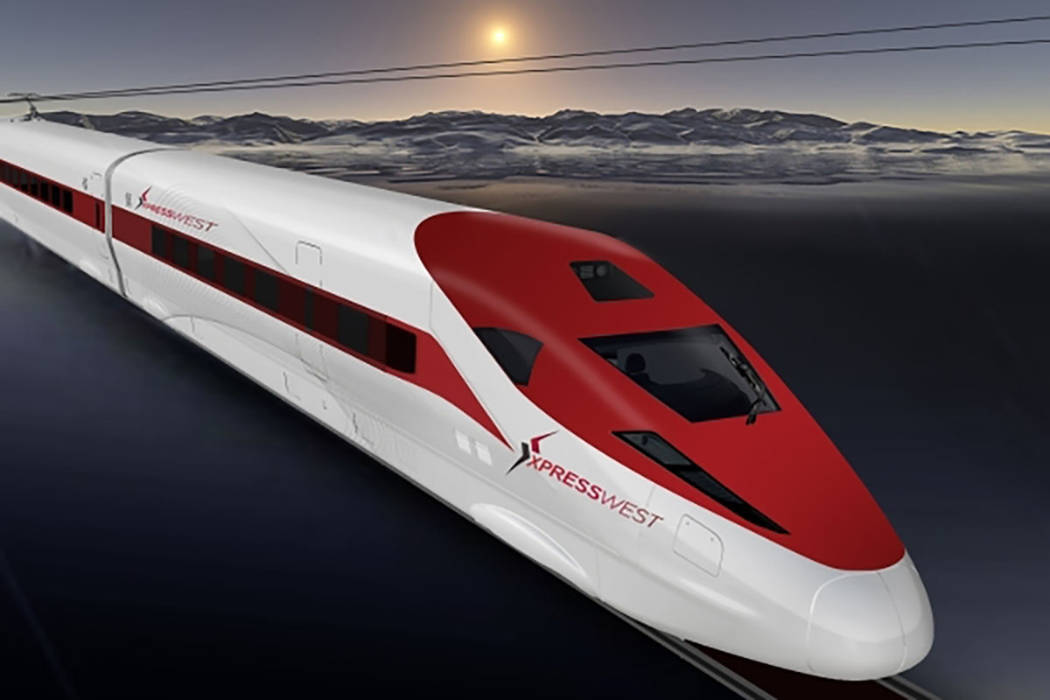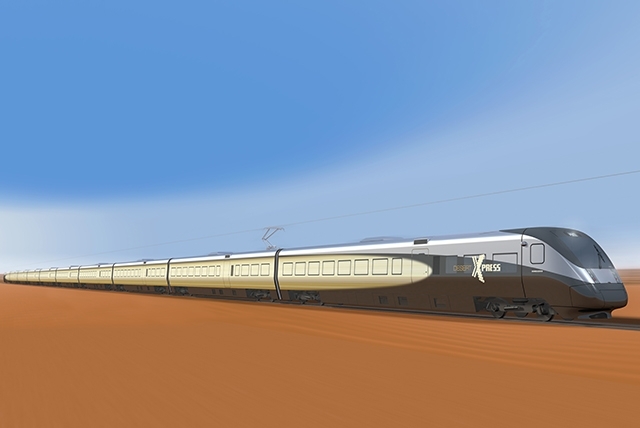Arrival of Las Vegas Raiders breathes new life into high-speed rail project


A high-speed rail project long left for dead by critics might have new life, thanks to a key study, the arrival of the Trump administration and an unexpected wild card — the Las Vegas Raiders.
The recently completed investment grade ridership and revenue forecast study completed by Southern California’s High Desert Corridor Joint Powers Authority reiterated what longtime Las Vegas developer Tony Marnell has suspected all along — that there would be significant demand for the XpressWest high-speed rail project linking Southern California with Las Vegas he wants to build.
President Donald Trump’s desire to invest in infrastructure projects, the favorable ridership study and a new reason for Southern Californians to make quick trips to Las Vegas in a few years — NFL football games, concerts and other special events — add up to new hope to press forward on the $7 billion rail project that has been under consideration for more than a decade.
Marnell discussed the study, the Trump administration’s role and the Raiders in an exclusive interview last week with the Review-Journal.
“We all know that the Republicans are not big advocates of spending money on infrastructure, although this president is one of the first presidents to come along in a long time that recognizes the country needs another investment in infrastructure and it needs an investment in 21st century technology,” Marnell said.
Experienced builder
Marnell, a longtime Southern Nevada developer best known as the builder of The Mirage, Treasure Island, Bellagio and Wynn Las Vegas, received welcome news last month when the authority, looking to build a new freeway that includes a high-speed rail corridor, received a study from a top transportation forecasting consultant that says an estimated 27 percent of travelers from Southern California would take high-speed rail to Las Vegas if it existed.
This report said the ridership demand combined with the cost of round-trip tickets, which would average $115 — priced competitively to rival other travel options — would generate more than $1 billion a year in operating revenue when the system is fully operational in 2035.
A train could be running sooner, Marnell said, with an estimated two to three years to ramp up and four to five to build.
But representatives of the authority expect the results of the study, conducted by Boston-based Steer Davies Gleave, will drive private investment in the train system, which would link Las Vegas with Los Angeles and Anaheim, California, by way of Victorville and Palmdale, California.
XpressWest has environmental approvals and clearances to build between Las Vegas and Victorville, primarily along the Interstate 15 corridor, and the authority recently completed environmental work on the link between Victorville and Palmdale along the new freeway route, known as the High Desert Corridor.
Los Angeles Metro rail lines already exist between Anaheim, Los Angeles, Burbank and Palmdale, but high-speed designs would need to be built as a part of the California High Speed Rail project connecting Los Angeles and San Francisco.
Big announcement
Authority leaders recognized the significance of the report when they announced it March 2.
“This confirms that the rail connector component of the High Desert Corridor will add merit to attract private investors and builders and give credibility that will justify public support — key ingredients to a successful public-private partnership,” said San Bernardino County Supervisor Robert Lovingood, who chairs the authority and is president of the San Bernardino County Transportation Authority.
Marnell is happy that the Steer Davies Gleave study validated the ridership study his company completed when the XpressWest was first unveiled, and he contends that Inland Empire residents would be willing to drive to and park in Victorville and take the train to Las Vegas, eliminating the longest portion of a car trip.
But he doesn’t expect a flood of private investment.
“It’s opened things up for another group of people interested, but the problem has always been the same for us,” Marnell said. “Our project takes four to five years to build and two to three years to ramp up. People are looking for much quicker returns on their money. That is the problem with infrastructure. The banking groups are out of that business now. I haven’t seen a loan like that lately, and we need a longer-term loan.”
Government loan
That’s why Marnell is hoping to take another swing at securing a loan through the Federal Railroad Administration’s Railroad Rehabilitation and Improvement Financing loan program. The Obama administration was urged to require that loan recipients buy American-built materials. That was problematic because there are no American suppliers for high-speed rail.
With Donald Trump in office — an advocate for public works projects that will put people to work — Marnell thinks there may be an opportunity to secure a loan.
Ironically, two Republican senators who created the biggest roadblock in XpressWest’s bid to secure a loan now have different roles in the federal government hierarchy. Former Sen. Jeff Sessions, R-Ala., is now attorney general, and Rep. Paul Ryan, R-Wis., is speaker of the House.
Sessions and Ryan penned a letter in March 2013 to then-Transportation Secretary Ray LaHood urging the department to suspend consideration of a Railroad Rehabilitation and Improvement Financing loan to XpressWest.
Letter to LaHood
In their letter to LaHood, Sessions and Ryan wrote that such loans “are incredibly generous to the borrower,” and they urged directing loans “to more worthy transportation infrastructure projects that could truly provide a reasonable rate of return to the taxpayers of this nation.”
“We are deeply troubled by the prospects of subsidizing another costly, wasteful and risky high-speed rail project, particularly when our nation is facing a debt crisis that threatens the well-being of the current and future generations of Americans,” the letter said.
How that would play today within the Trump administration is an unknown, and Marnell is convinced that there are others within Congress who would attempt to block efforts for the company to secure a loan, though XpressWest has made the case that “Buy American” clauses within the approval process are irrelevant since there are no American high-speed rail manufacturers.
Marnell said the big problem now is that “the government is broken” and Democrats are doing everything they can to block the approval of Trump appointees to key decision-making positions within the administration.
Democratic roadblock
“What we are all hearing publicly from the administration is correct,” Marnell said. “Democrats are going to make this as hard as they can to get appointments approved.”
Marnell said it could take a year for some appointments in key positions to be made. He said that XpressWest is one of the few shovel-ready transportation infrastructure projects available for immediate consideration.
“Are there $1 billion worth of shovel-ready projects a year for the next 10 years? The answer to that question is no. But there are a few of them, and we’re one of them,” Marnell said.
The wild card in the equation is the sudden appearance of the Raiders in Southern Nevada. The NFL owners’ approval of the team’s relocation came in late March, well after the ridership study was completed.
“They did not take into account the stadium at all,” said Karen Hedlund, a consultant to the High Desert Corridor Joint Powers Authority and a former deputy administrator of the Federal Railroad Administration in the Obama administration.
But she added that any new ridership resulting from the stadium would be a plus for XpressWest.
Weekend traffic
“Most of the traffic going to Las Vegas for an event at the stadium would be heavily weighted toward the weekend, so this would just add to that,” Hedlund said in a telephone interview.
“But it would give fans in the L.A. basin an easy alternative to get to Las Vegas, and I would think the owners of the stadium and the Raiders would be very interested in the availability of this connection,” she said.
Marnell concurs.
“That’s the kind of society we have now: One-day trips with the transportation that is available to us now is a big piece of business,” he said. “Southern California — it’s really the Inland Empire — which is what we’ve been talking about forever, drives the (casino) slot customer. I’m going to think it’s also where we’re going to find the Raiders’ biggest fan base.”
But Marnell isn’t completely sold on the Raiders top stadium location site — and it isn’t because XpressWest considered the same land for a potential train station.
Speedway example
Marnell worries that the same type of traffic jams that occur during big events at the Las Vegas Motor Speedway — NASCAR races and the Electric Daisy Carnival — would occur every other Sunday in the fall near I-15 and Tropicana Avenue if the stadium is built at the Russell Road site. He expects the Stadium Authority to encourage the Raiders to put the stadium farther south along I-15 to keep Tropicana clear for tourists looking to get to McCarran International Airport on weekend getaway days.
“Traffic studies we did for that location more than clarify that there is no possible way to handle the traffic going to a stadium there,” Marnell said.
“It’s not even close. Nobody is going to make the same mistake they made north of Las Vegas (near the speedway).”
But that’s a debate for another day, and Marnell is more focused on his train than the stadium for now.
“I just think everybody just needs to take a really big breath.”
Contact Richard N. Velotta at rvelotta@reviewjournal.com or 702-477-3893. Follow @RickVelotta on Twitter.
RELATED ARTICLES
High-speed rail system most desired transportation mode for Las Vegans
UNLV gets $1.4M grant to study high-speed rail
XpressWest executives have talked Hyperloop One about high-speed rail project
Analysts: Build high-speed rail, not more lanes for I-15












